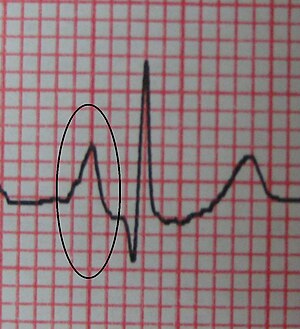Right atrial enlargement
| Right atrial enlargement | |
|---|---|
 | |
| Right atrial enlargement (P pulmonale) | |
| Causes | Pulmonary Hypertension |
Right atrial enlargement (RAE) is a form of cardiomegaly, or heart enlargement. It can broadly be classified as either right atrial hypertrophy (RAH), overgrowth, or dilation, like an expanding balloon. Common causes include pulmonary hypertension, which can be the primary defect leading to RAE, or pulmonary hypertension secondary to tricuspid stenosis; pulmonary stenosis or Tetralogy of Fallot i.e. congenital diseases; chronic lung disease, such as . Other recognised causes are: right ventricular failure, tricuspid regurgitation, and atrial septal defect.[1]
Diagnosis[]
It is characterized by a high P wave amplitude (P pulmonale), i.e. a height greater than 2.5 mm in inferior ECG leads (II, III, aVF); and greater than 1.5 mm in right sided precordial leads (V1, V2). [2]
References[]
- ^ "Size of the right atrium and associated structures". 123 sonography.com. Medical University of Vienna. 2012-08-20. Retrieved 13 December 2016.
- ^ Frank G Yanowitz MD. "Right Atrial Enlargement". ecg learning center. Eccles Health Sciences Library University of Utah. Retrieved 13 December 2016.
- Cardiomegaly
- Circulatory disease stubs